Portal maintenance status: (June 2018)
|
| Main page | Content, Categories & Topics | WikiProjects & Things you can do |
The Baseball Portal
.jpg.webp)
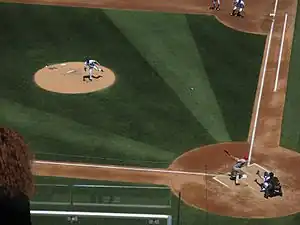
Baseball is a bat-and-ball sport played between two teams of nine players each, taking turns batting and fielding. The game occurs over the course of several plays, with each play generally beginning when a player on the fielding team, called the pitcher, throws a ball that a player on the batting team, called the batter, tries to hit with a bat. The objective of the offensive team (batting team) is to hit the ball into the field of play, away from the other team's players, allowing its players to run the bases, having them advance counter-clockwise around four bases to score what are called "runs". The objective of the defensive team (referred to as the fielding team) is to prevent batters from becoming runners, and to prevent runners' advance around the bases. A run is scored when a runner legally advances around the bases in order and touches home plate (the place where the player started as a batter).
The opposing teams switch back and forth between batting and fielding; the batting team's turn to bat is over once the fielding team records three outs. One turn batting for each team constitutes an inning. A game is usually composed of nine innings, and the team with the greater number of runs at the end of the game wins. Most games end after the ninth inning, but if scores are tied at that point, extra innings are usually played. Baseball has no game clock, though some competitions feature pace-of-play regulations such as the pitch clock to shorten game time.
Baseball evolved from older bat-and-ball games already being played in England by the mid-18th century. This game was brought by immigrants to North America, where the modern version developed. Baseball's American origins, as well as its reputation as a source of escapism during troubled points in American history such as the American Civil War and the Great Depression, have led the sport to receive the moniker of "America's Pastime"; since the late 19th century, it has been unofficially recognized as the national sport of the United States, though in modern times is considered less popular than other sports, such as American football. In addition to North America, baseball is considered the most popular sport in parts of Central and South America, the Caribbean, and East Asia, particularly in Japan, South Korea, and Taiwan. (Full article...)
 Featured articles -
Featured articles -
 Image 1
Image 1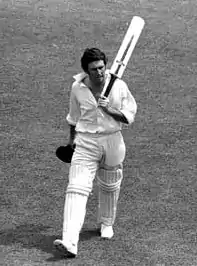
Ian Michael Chappell (born 26 September 1943) is a former cricketer who played for South Australia and Australia. He captained Australia between 1971 and 1975 before taking a central role in the breakaway World Series Cricket organisation. Born into a cricketing family—his grandfather and brother also captained Australia—Chappell made a hesitant start to international cricket playing as a right-hand middle-order batsman and spin bowler. He found his niche when promoted to bat at number three. Known as "Chappelli", he earned a reputation as one of the greatest captains the game has seen. Chappell's blunt verbal manner led to a series of confrontations with opposition players and cricket administrators; the issue of sledging first arose during his tenure as captain, and he was a driving force behind the professionalisation of Australian cricket in the 1970s.
John Arlott called him "a cricketer of effect rather than the graces". An animated presence at the batting crease, he constantly adjusted his equipment and clothing, and restlessly tapped his bat on the ground as the bowler ran in. Basing his game on a sound defence learned during many hours of childhood lessons, Chappell employed the drive and square cut to full effect. He had an idiosyncratic method of playing back and across to a ball of full length and driving wide of mid-on, but his trademark shot was the hook, saying "three bouncers an over should be worth 12 runs to me". A specialist slip fielder, he was the fourth player to take one hundred Test catches. (Full article...) Image 2
Image 2.png.webp) Baldwin photographed in c. 1890
Baldwin photographed in c. 1890
Marcus Elmore Baldwin (October 29, 1863 – November 10, 1929), nicknamed "Fido" and "Baldy", was an American right-handed professional baseball pitcher who played seven seasons in Major League Baseball (MLB). In 346 career games, he pitched to a 154–165 win–loss record with 295 complete games. Baldwin set the single-season MLB wild pitches record with 83 that still stands today.
Born in Pittsburgh, Pennsylvania, Baldwin made his professional debut for a Cumberland, Maryland team in 1883. Though signed by Chicago White Stockings president Albert Spalding to pitch against the St. Louis Browns in the 1886 World Series, Baldwin did not play after Browns objected. He made his MLB debut for the White Stockings in 1887, when a writer for the Oshkosh Daily Northwestern called him the "swiftest pitcher in the National League" (NL). Released by Chicago player–manager Cap Anson, he signed with the Columbus Solons of the American Association (AA) in 1889, where he led the league in innings pitched (513+2⁄3), losses (34), strikeouts (368), and walks (274). (Full article...) Image 3
Image 3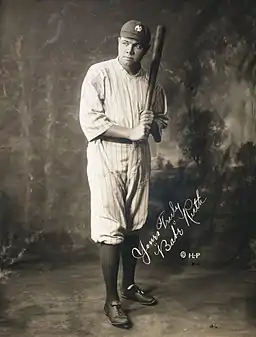 Ruth in 1920
Ruth in 1920
George Herman "Babe" Ruth (February 6, 1895 – August 16, 1948) was an American professional baseball player whose career in Major League Baseball (MLB) spanned 22 seasons, from 1914 through 1935. Nicknamed "the Bambino" and "the Sultan of Swat", he began his MLB career as a star left-handed pitcher for the Boston Red Sox, but achieved his greatest fame as a slugging outfielder for the New York Yankees. Ruth is regarded as one of the greatest sports heroes in American culture and is considered by many to be the greatest baseball player of all time. In 1936, Ruth was elected into the Baseball Hall of Fame as one of its "first five" inaugural members.
At age seven, Ruth was sent to St. Mary's Industrial School for Boys, a reformatory where he was mentored by Brother Matthias Boutlier of the Xaverian Brothers, the school's disciplinarian and a capable baseball player. In 1914, Ruth was signed to play Minor League baseball for the Baltimore Orioles but was soon sold to the Red Sox. By 1916, he had built a reputation as an outstanding pitcher who sometimes hit long home runs, a feat unusual for any player in the dead-ball era. Although Ruth twice won 23 games in a season as a pitcher and was a member of three World Series championship teams with the Red Sox, he wanted to play every day and was allowed to convert to an outfielder. With regular playing time, he broke the MLB single-season home run record in 1919 with 29. (Full article...) Image 4
Image 4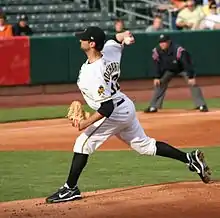 Adenhart pitching for the Salt Lake Bees in 2008
Adenhart pitching for the Salt Lake Bees in 2008
Nicholas James Adenhart (August 24, 1986 – April 9, 2009) was an American right-handed baseball starting pitcher who played parts of two seasons in Major League Baseball (MLB) for the Los Angeles Angels of Anaheim. In just four career games, Adenhart pitched 18 innings and posted a win–loss record of 1–0.
A graduate of Williamsport High School, Adenhart was highly touted as a high school prospect until an injury in his final game required Tommy John surgery. He was drafted by the Angels in the 14th round of the 2004 Major League Baseball draft, and began playing in their minor league system after the surgery was a success. He spent three full seasons in the minor leagues before making his major league debut on May 1, 2008. After appearing in three games, Adenhart spent the rest of 2008 in the minor leagues developing his skills, and in 2009 he earned a spot in the Angels' starting rotation. (Full article...) Image 5
Image 5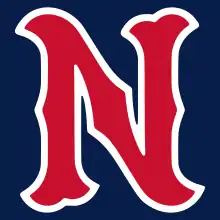
The Nashville Sounds are a Minor League Baseball team of the International League and the Triple-A affiliate of the Milwaukee Brewers. They are located in Nashville, Tennessee, and are named for the city's association with the music industry, specifically the "Nashville sound", a subgenre of country music which originated in the city and became popular in the mid-1950s. The team plays their home games at First Horizon Park, which opened in 2015 on the site of the historic Sulphur Dell ballpark. The Sounds previously played at Herschel Greer Stadium from its opening in 1978 until the end of the 2014 season. They are the oldest active professional sports franchise in Nashville.
Established as an expansion team of the Double-A Southern League in 1978, the Sounds led all of Minor League Baseball in attendance in their inaugural season and continued to draw the Southern League's largest crowds in each of their seven years as members of the league. On the field, the team won six consecutive second-half division titles from 1979 to 1984 and won the Southern League championship twice: in 1979 as the Double-A affiliate of the Cincinnati Reds and again in 1982 as the Double-A affiliate of the New York Yankees. (Full article...) Image 6
Image 6 Advertisement in Billboard magazine in 1907
Advertisement in Billboard magazine in 1907
How Brown Saw the Baseball Game is an American short silent comedy film produced in 1907 and distributed by the Lubin Manufacturing Company. The film follows a baseball fan named Mr. Brown who drinks large quantities of alcohol before a baseball game and becomes so intoxicated that the game appears to him in reverse motion. During production, trick photography was used to achieve this effect.
The film was released in November 1907. It received a positive review in a 1908 issue of The Courier-Journal that reported the film was successful and "truly funny". , it is unclear whether a print of the film has survived. The identities of the film's cast and production crew are unknown. Film historians have noted similarities between the plot of How Brown Saw the Baseball Game and the Edwin S. Porter-directed comedy film How the Office Boy Saw the Ball Game released the previous year. (Full article...) Image 7
Image 7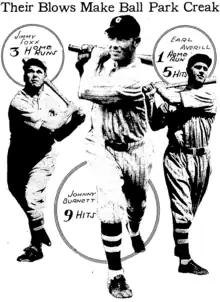
On July 10, 1932, the Philadelphia Athletics defeated the Cleveland Indians 18–17 in eighteen innings, in a Major League Baseball game played at League Park in Cleveland. Several records were set during the game; Johnny Burnett of the Indians became the only player to hit safely nine (or even eight) times in a major league game. Cleveland's 33 hits and the combined number of hits by the two teams (58) are also major league records for a single game. Pitcher Eddie Rommel secured the win for the Athletics, pitching an American League record seventeen innings in relief after Philadelphia's Lew Krausse gave up three runs in the first inning. The 29 hits Rommel allowed are a major league record; the fourteen runs against him are also a major league record for the most allowed by a winning pitcher.
Coming into the game, the Athletics, who were the three-times defending American League champions, trailed the New York Yankees in the standings by 71⁄2 games. Sunday baseball was still illegal in Philadelphia, forcing the Athletics to make one-game road trips on some Sundays, including July 10. With his pitching staff exhausted by six games in the previous three days, the owner and manager of the Athletics, Connie Mack, took only two pitchers on the train trip to Cleveland, giving the rest of the staff the day off. With no chance of being relieved except by a position player, Rommel pitched with mixed effectiveness, giving up six runs in the seventh inning but only two runs in the final nine innings of the game. He aided his own cause by getting three hits in seven at bats. Cleveland's Wes Ferrell took the loss after Jimmie Foxx got his sixth hit of the game and then scored. Foxx had already batted in eight runs, having hit three home runs and accumulated sixteen total bases, tying a record that has since been broken. (Full article...) Image 8
Image 8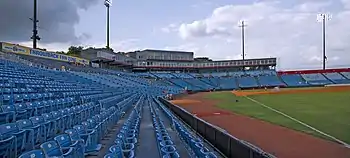 Greer's blue seating bowlA view of Greer from the right field seats
Greer's blue seating bowlA view of Greer from the right field seats
Herschel Greer Stadium was a Minor League Baseball park in Nashville, Tennessee, on the grounds of Fort Negley, an American Civil War fortification, approximately two mi (3.2 km) south of the city's downtown district. The facility closed at the end of the 2014 baseball season and remained deserted for over four years until its demolition in 2019. Following an archaeological survey, the land is expected to be reincorporated into Fort Negley Park.
Greer was opened in 1978 for the Nashville Sounds, an expansion franchise of the Double-A Southern League who moved to the Triple-A American Association in 1985 and to the Triple-A Pacific Coast League in 1998. The stadium played host to the team until 2014. The subject of numerous upgrades and repairs to maintain its functionality, Greer became one of the oldest stadiums used by a Triple-A team and had fallen well below professional baseball's standards for a stadium at that class level by the end of its use. For over a decade, the Sounds attempted to secure agreements with the Metropolitan Government of Nashville and Davidson County for a new ballpark to replace Greer, eventually resulting in the construction of First Tennessee Park, which became the Sounds' new home in 2015. (Full article...) Image 9
Image 9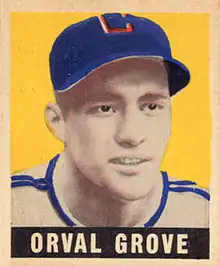 Orval Grove in 1948
Orval Grove in 1948
Orval Leroy Grove (August 29, 1919 – April 20, 1992) was an American pitcher in Major League Baseball who played for ten seasons in the American League with the Chicago White Sox. In 207 career games, Grove pitched 1,176 innings and posted a win–loss record of 63–73, with 66 complete games, 11 shutouts, and a 3.78 earned run average (ERA).
The only freshman on the Proviso Township High School varsity baseball team, Grove's pitching ability attracted the attention of the White Sox. After signing with the team in 1937, Grove moved between the major leagues and minor leagues for a few seasons until 1943, when he found a solid place in the White Sox's pitching rotation. Grove had a career-year in 1943, finishing the season with career-bests in ERA, wins, and complete games; in 1944, he made his only All-Star appearance. (Full article...) Image 10
Image 10 Los Angeles Angels center fielder Mike Trout hits a home run on a pitch from New York Mets pitcher Tommy Milone on May 21, 2017
Los Angeles Angels center fielder Mike Trout hits a home run on a pitch from New York Mets pitcher Tommy Milone on May 21, 2017
Baseball is a bat-and-ball sport played between two teams of nine players each, taking turns batting and fielding. The game occurs over the course of several plays, with each play generally beginning when a player on the fielding team, called the pitcher, throws a ball that a player on the batting team, called the batter, tries to hit with a bat. The objective of the offensive team (batting team) is to hit the ball into the field of play, away from the other team's players, allowing its players to run the bases, having them advance counter-clockwise around four bases to score what are called "runs". The objective of the defensive team (referred to as the fielding team) is to prevent batters from becoming runners, and to prevent runners' advance around the bases. A run is scored when a runner legally advances around the bases in order and touches home plate (the place where the player started as a batter).
The principal objective of the batting team is to have a player reach first base safely; this generally occurs either when the batter hits the ball and reaches first base before an opponent retrieves the ball and touches the base, or when the pitcher persists in throwing the ball out of the batter's reach. Players on the batting team who reach first base without being called "out" can attempt to advance to subsequent bases as a runner, either immediately or during teammates' turns batting. The fielding team tries to prevent runs by getting batters or runners "out", which forces them out of the field of play. The pitcher can get the batter out by throwing three pitches which result in strikes, while fielders can get the batter out by catching a batted ball before it touches the ground, and can get a runner out by tagging them with the ball while the runner is not touching a base. (Full article...) Image 11
Image 11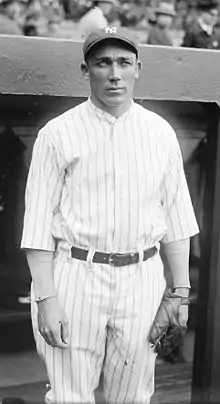 Paschal before a game during the 1925 New York Yankees season
Paschal before a game during the 1925 New York Yankees season
Benjamin Edwin Paschal (October 13, 1895 – November 10, 1974) was an American baseball outfielder who played eight seasons in Major League Baseball from 1915 to 1929, mostly for the New York Yankees. After two "cup of coffee" stints with the Cleveland Indians in 1915 and the Boston Red Sox in 1920, Paschal spent most of his career as the fourth outfielder and right-handed pinch hitter of the Yankees' Murderers' Row championship teams of the late 1920s. Paschal is best known for hitting .360 in the 1925 season while standing in for Babe Ruth, who missed the first 40 games with a stomach ailment.
During his time in baseball, Paschal was described as a five-tool player who excelled at running, throwing, fielding, hitting for average, and power. However, his playing time with the Yankees was limited because they already had future Baseball Hall of Famers Ruth and Earle Combs, and star Bob Meusel, in the outfield. Paschal was considered one of the best bench players in baseball during his time with the Yankees, and sportswriters wrote how he would have started for most other teams in the American League. He was one of the best pinch hitters in the game during the period, at a time when the term was still relatively new to baseball. (Full article...) Image 12Disco Demolition Night was a Major League Baseball (MLB) promotion on Thursday, July 12, 1979, at Comiskey Park in Chicago, Illinois, that ended in a riot. At the climax of the event, a crate filled with disco records was blown up on the field between games of the twi-night doubleheader between the Chicago White Sox and the Detroit Tigers. Many had come to see the explosion rather than the games and rushed onto the field after the detonation. The playing field was so damaged by the explosion and by the rioters that the White Sox were required to forfeit the second game to the Tigers.
Image 12Disco Demolition Night was a Major League Baseball (MLB) promotion on Thursday, July 12, 1979, at Comiskey Park in Chicago, Illinois, that ended in a riot. At the climax of the event, a crate filled with disco records was blown up on the field between games of the twi-night doubleheader between the Chicago White Sox and the Detroit Tigers. Many had come to see the explosion rather than the games and rushed onto the field after the detonation. The playing field was so damaged by the explosion and by the rioters that the White Sox were required to forfeit the second game to the Tigers.
In the late 1970s, dance-oriented disco was the most popular music genre in the United States, particularly after being featured in hit films such as Saturday Night Fever (1977). However, disco sparked a major backlash from rock music fans—an opposition prominent enough that the White Sox, seeking to fill seats at Comiskey Park during a lackluster season, engaged Chicago shock jock and anti-disco campaigner Steve Dahl for the promotion at the July 12 doubleheader. Dahl's sponsoring radio station was WLUP (97.9 FM, now WCKL), so admission was discounted to 98 cents for attendees who turned in a disco record; between games, Dahl was to destroy the collected vinyl in an explosion. (Full article...) Image 13
Image 13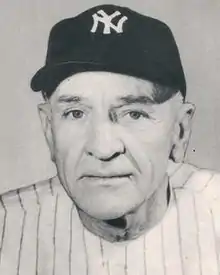 Stengel in 1957
Stengel in 1957
Charles Dillon "Casey" Stengel (/ˈstɛŋɡəl/; July 30, 1890 – September 29, 1975) was an American Major League Baseball right fielder and manager, best known as the manager of the championship New York Yankees of the 1950s and later, the expansion New York Mets. Nicknamed "the Ol' Perfessor", he was elected to the Baseball Hall of Fame in 1966.
Stengel was born in Kansas City, Missouri, in 1890. In 1910, he began a professional baseball career that would span over half a century. After almost three seasons in the minor leagues, Stengel reached the major leagues late in 1912, as an outfielder, for the Brooklyn Dodgers. His six seasons there saw some success, among them playing for Brooklyn's 1916 National League championship team; but he also developed a reputation as a clown. After repeated clashes over pay with the Dodgers owner, Charlie Ebbets, Stengel was traded to the Pittsburgh Pirates in 1918; however, he enlisted in the Navy that summer, for the remainder of World War I. After returning to baseball, he continued his pay disputes, resulting in trades to the Philadelphia Phillies (in 1919) and to the New York Giants (in 1921). There, he learned much about baseball from the manager, John McGraw, and had some of the glorious moments in his career, such as hitting an inside-the-park home run in Game 1 of the 1923 World Series to defeat the Yankees. His major league playing career ended with the Boston Braves in 1925, but he then began a career as a manager. (Full article...) Image 14
Image 14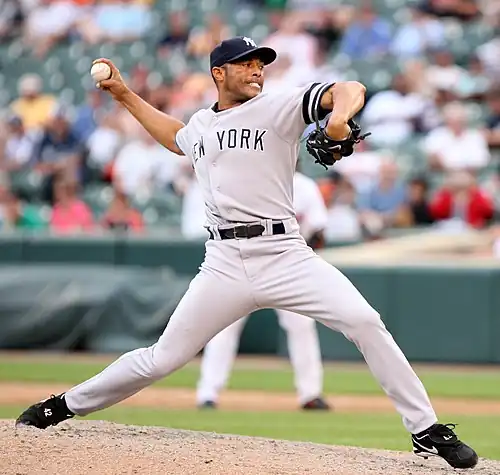 Rivera with the New York Yankees in 2007
Rivera with the New York Yankees in 2007
Mariano Rivera (born November 29, 1969) is a Panamanian-American former professional baseball pitcher who played 19 seasons in Major League Baseball (MLB) for the New York Yankees, from 1995 to 2013. Nicknamed "Mo" and "Sandman", he spent most of his career as a relief pitcher and served as the Yankees' closer for 17 seasons. A thirteen-time All-Star and five-time World Series champion, he is MLB's career leader in saves (652) and games finished (952). Rivera won five American League (AL) Rolaids Relief Man Awards and three Delivery Man of the Year Awards, and he finished in the top three in voting for the AL Cy Young Award four times. He was inducted into the Baseball Hall of Fame as part of its class of 2019 in his first year of eligibility, and is to date the only player ever to be elected unanimously by the Baseball Writers' Association of America (BBWAA).
Raised in the modest Panamanian fishing village of Puerto Caimito, Rivera was an amateur player until he was signed by the Yankees organization in 1990. He debuted in the major leagues in 1995 as a starting pitcher, before permanently converting to a relief pitcher late in his rookie year. After a breakthrough season in 1996 as a setup man, he became the Yankees' closer in 1997. In the following seasons, he established himself as one of baseball's top relievers, leading the major leagues in saves in 1999, 2001, and 2004. Rivera primarily threw a sharp-moving, mid-90s mile-per-hour cut fastball that frequently broke hitters' bats and earned a reputation as one of the league's toughest pitches to hit. With his presence at the end of games, signaled by his foreboding entrance song "Enter Sandman", Rivera was a key contributor to the Yankees' success in the late 1990s and early 2000s. An accomplished postseason performer, he was named the 1999 World Series Most Valuable Player (MVP) and the 2003 AL Championship Series MVP, and he holds several postseason records, including lowest earned run average (ERA) (0.70) and most saves (42). (Full article...) Image 15
Image 15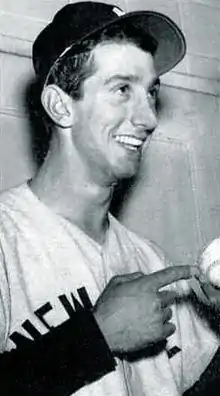 Martin with the Yankees in 1954
Martin with the Yankees in 1954
Alfred Manuel Martin Jr. (May 16, 1928 – December 25, 1989), commonly called "Billy", was an American Major League Baseball second baseman and manager who, in addition to leading other teams, was five times the manager of the New York Yankees. First known as a scrappy infielder who made considerable contributions to the championship Yankee teams of the 1950s, he then built a reputation as a manager who would initially make bad teams good, before ultimately being fired amid dysfunction. In each of his stints with the Yankees he managed them to winning records before being fired by team owner George Steinbrenner or resigning under fire, usually amid a well-publicized scandal such as Martin's involvement in an alcohol-fueled fight.
Martin was born in a working-class section of Berkeley, California. His skill as a baseball player gave him a route out of his home town. Signed by the Pacific Coast League Oakland Oaks, Martin learned much from Casey Stengel, the man who would manage him both in Oakland and in New York, and enjoyed a close relationship with Stengel. Martin's spectacular catch of a wind-blown Jackie Robinson popup late in Game Seven of the 1952 World Series saved that series for the Yankees, and he was the hitting star of the 1953 World Series, earning the Most Valuable Player award in the Yankee victory. He missed most of two seasons, 1954 and 1955, after being drafted into the Army, and his abilities never fully returned; the Yankees traded him after a brawl at the Copacabana club in New York during the 1957 season. Martin bitterly resented being traded, and did not speak to Stengel for years, a time during which Martin completed his playing career with various teams. (Full article...)
General images -
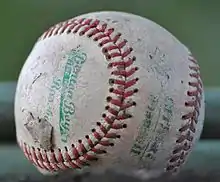 Image 1A well-worn baseball (from Baseball)
Image 1A well-worn baseball (from Baseball) Image 2A New York Yankees batter (Andruw Jones) and a Boston Red Sox catcher at Fenway Park (from Baseball)
Image 2A New York Yankees batter (Andruw Jones) and a Boston Red Sox catcher at Fenway Park (from Baseball)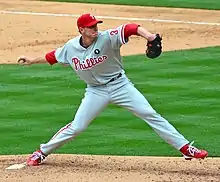 Image 3In May 2010, the Philadelphia Phillies' Roy Halladay pitched the 20th major league perfect game. That October, he pitched only the second no-hitter in MLB postseason history. (from History of baseball)
Image 3In May 2010, the Philadelphia Phillies' Roy Halladay pitched the 20th major league perfect game. That October, he pitched only the second no-hitter in MLB postseason history. (from History of baseball)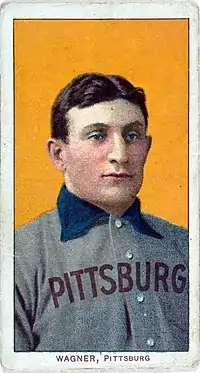 Image 4The American Tobacco Company's line of baseball cards featured shortstop Honus Wagner of the Pittsburgh Pirates from 1909 to 1911. In 2007, the card shown here sold for $2.8 million. (from Baseball)
Image 4The American Tobacco Company's line of baseball cards featured shortstop Honus Wagner of the Pittsburgh Pirates from 1909 to 1911. In 2007, the card shown here sold for $2.8 million. (from Baseball) Image 5Fenway Park, home of the Boston Red Sox. The Green Monster is visible beyond the playing field on the left. (from Baseball)
Image 5Fenway Park, home of the Boston Red Sox. The Green Monster is visible beyond the playing field on the left. (from Baseball).jpg.webp) Image 6Alexander Cartwright, father of modern baseball (from History of baseball)
Image 6Alexander Cartwright, father of modern baseball (from History of baseball)_in_the_Cantigas_de_Santa_Maria.jpg.webp) Image 7A game from the Cantigas de Santa Maria, c. 1280, involving tossing a ball, hitting it with a stick and competing with others to catch it (from History of baseball)
Image 7A game from the Cantigas de Santa Maria, c. 1280, involving tossing a ball, hitting it with a stick and competing with others to catch it (from History of baseball)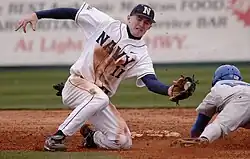
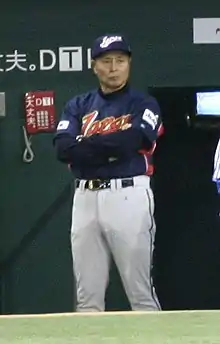 Image 9Sadaharu Oh managing the Japan national team in the 2006 World Baseball Classic. Playing for the Central League's Yomiuri Giants (1959–80), Oh set the professional world record for home runs with 868. (from History of baseball)
Image 9Sadaharu Oh managing the Japan national team in the 2006 World Baseball Classic. Playing for the Central League's Yomiuri Giants (1959–80), Oh set the professional world record for home runs with 868. (from History of baseball)
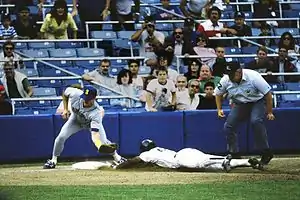 Image 11Rickey Henderson—the major leagues' all-time leader in runs and stolen bases—stealing third base in a 1988 game (from Baseball)
Image 11Rickey Henderson—the major leagues' all-time leader in runs and stolen bases—stealing third base in a 1988 game (from Baseball)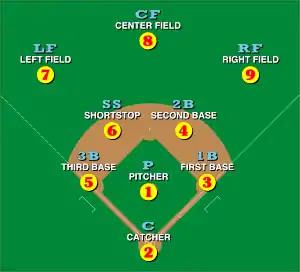 Image 12Defensive positions on a baseball field, with abbreviations and scorekeeper's position numbers (not uniform numbers) (from Baseball)
Image 12Defensive positions on a baseball field, with abbreviations and scorekeeper's position numbers (not uniform numbers) (from Baseball)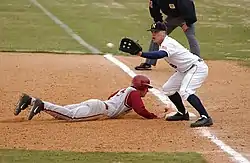 Image 13Pick-off attempt on runner (in red) at first base (from Baseball rules)
Image 13Pick-off attempt on runner (in red) at first base (from Baseball rules) Image 14The typical motion of a right-handed pitcher (from Baseball rules)
Image 14The typical motion of a right-handed pitcher (from Baseball rules) Image 15Sadaharu Oh managing the Japan national team in the 2006 World Baseball Classic. Playing for the Central League's Yomiuri Giants (1959–80), Oh set the professional world record for home runs. (from Baseball)
Image 15Sadaharu Oh managing the Japan national team in the 2006 World Baseball Classic. Playing for the Central League's Yomiuri Giants (1959–80), Oh set the professional world record for home runs. (from Baseball)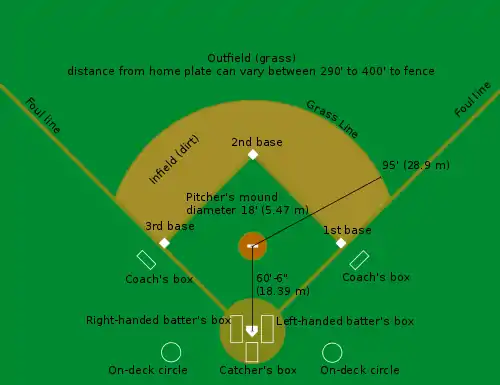 Image 16Diagram of a baseball field Diamond may refer to the square area defined by the four bases or to the entire playing field. The dimensions given are for professional and professional-style games. Children often play on smaller fields. (from Baseball)
Image 16Diagram of a baseball field Diamond may refer to the square area defined by the four bases or to the entire playing field. The dimensions given are for professional and professional-style games. Children often play on smaller fields. (from Baseball).jpg.webp)
 Image 18Two players on the baseball team of Tokyo, Japan's Waseda University in 1921 (from Baseball)
Image 18Two players on the baseball team of Tokyo, Japan's Waseda University in 1921 (from Baseball)
 Image 20A first baseman receives a pickoff throw, as the runner dives back to first base. (from Baseball)
Image 20A first baseman receives a pickoff throw, as the runner dives back to first base. (from Baseball)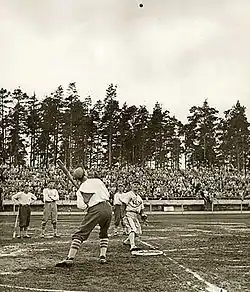 Image 21Pesäpallo, a Finnish variation of baseball, was invented by Lauri "Tahko" Pihkala in the 1920s, and after that, it has changed with the times and grown in popularity. Picture of Pesäpallo match in 1958 in Jyväskylä, Finland. (from Baseball)
Image 21Pesäpallo, a Finnish variation of baseball, was invented by Lauri "Tahko" Pihkala in the 1920s, and after that, it has changed with the times and grown in popularity. Picture of Pesäpallo match in 1958 in Jyväskylä, Finland. (from Baseball)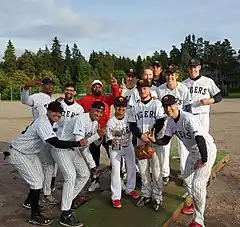
 Image 23Jackie Robinson in 1945, with the era's Kansas City Royals, a barnstorming squad associated with the Negro American League's Kansas City Monarchs (from Baseball)
Image 23Jackie Robinson in 1945, with the era's Kansas City Royals, a barnstorming squad associated with the Negro American League's Kansas City Monarchs (from Baseball).jpg.webp) Image 24Cover of Official Base Ball Rules, 1921 edition, used by the American League and National League (from Baseball rules)
Image 24Cover of Official Base Ball Rules, 1921 edition, used by the American League and National League (from Baseball rules) Image 25Jackie Robinson in 1945, with the era's Kansas City Royals, a barnstorming squad associated with the Negro American League's Kansas City Monarchs (from History of baseball)
Image 25Jackie Robinson in 1945, with the era's Kansas City Royals, a barnstorming squad associated with the Negro American League's Kansas City Monarchs (from History of baseball)
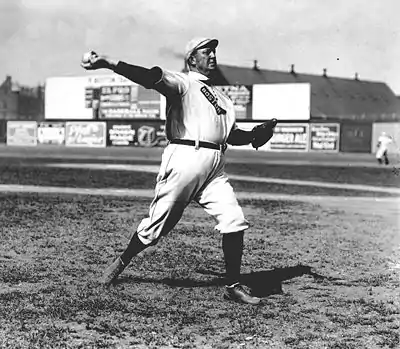 Image 27Cy Young—the holder of many major league career marks, including wins and innings pitched, as well as losses—in 1908. MLB's annual awards for the best pitcher in each league are named for Young. (from Baseball)
Image 27Cy Young—the holder of many major league career marks, including wins and innings pitched, as well as losses—in 1908. MLB's annual awards for the best pitcher in each league are named for Young. (from Baseball)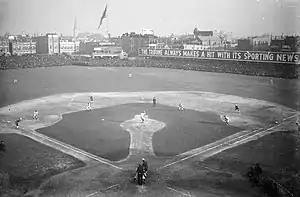 Image 281906 World Series, infielders playing "in" for the expected bunt and the possible play at the plate with the bases loaded (from Baseball rules)
Image 281906 World Series, infielders playing "in" for the expected bunt and the possible play at the plate with the bases loaded (from Baseball rules)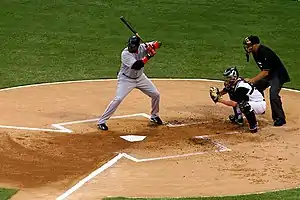
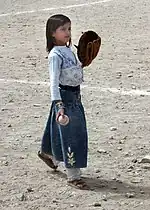 Image 30An Afghan girl playing baseball in August 2002 (from Baseball)
Image 30An Afghan girl playing baseball in August 2002 (from Baseball) Image 312013 World Baseball Classic championship match between the Dominican Republic and Puerto Rico, March 20, 2013 (from Baseball)
Image 312013 World Baseball Classic championship match between the Dominican Republic and Puerto Rico, March 20, 2013 (from Baseball)_(LOC).jpg.webp) Image 32The NL champion New York Giants baseball team, 1913. Fred Merkle, sixth in line, had committed a baserunning gaffe in a crucial 1908 game that became famous as Merkle's Boner. (from History of baseball)
Image 32The NL champion New York Giants baseball team, 1913. Fred Merkle, sixth in line, had committed a baserunning gaffe in a crucial 1908 game that became famous as Merkle's Boner. (from History of baseball)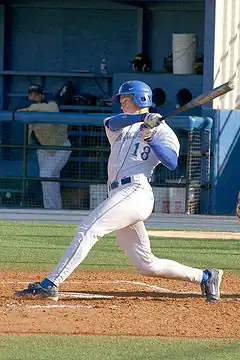 Image 33A batter follows through after swinging at a pitched ball. (from Baseball rules)
Image 33A batter follows through after swinging at a pitched ball. (from Baseball rules)
 Good articles -
Good articles -
 Image 1
Image 1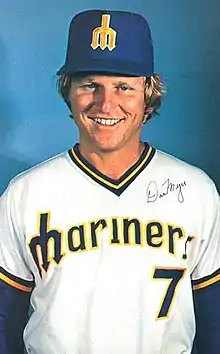 Meyer in 1978
Meyer in 1978
Daniel Thomas Meyer (born August 3, 1952) is an American retired professional baseball player whose career spanned 17 seasons, 12 of which were played in Major League Baseball (MLB) with the Detroit Tigers (1974–76), the Seattle Mariners (1977–81), and the Oakland Athletics (1982–85). Meyer primarily played first base, but also played left field, third base, and right field. He batted left-handed while throwing right-handed. During his playing career, Meyer was listed at 5 feet 11 inches (180 cm) and weighed 180 pounds (82 kg).
After attending the University of Arizona and Santa Ana College, Meyer was drafted by the Detroit Tigers during the 1972 Major League Baseball draft. He began his career in the minor leagues with the Bristol Tigers. Meyer made his major league debut in 1974. Over his career in the majors, Meyer compiled a .253 batting average with 411 runs scored, 944 hits, 153 doubles, 31 triples, 86 home runs, and 459 runs batted in (RBIs) in 1,118 games played. (Full article...) Image 2
Image 2.svg.png.webp)
WNUV (channel 54) is a television station in Baltimore, Maryland, United States, affiliated with The CW. It is owned by Cunningham Broadcasting, which maintains a local marketing agreement (LMA) with Sinclair Broadcast Group, owner of Fox/MyNetworkTV affiliate WBFF (channel 45), for the provision of programming and certain services. However, Sinclair effectively owns WNUV, as the majority of Cunningham's stock is owned by the family of deceased group founder Julian Smith. Sinclair also operates TBD affiliate WUTB (channel 24) under a separate shared services agreement with Deerfield Media. The stations share studios on 41st Street off the Jones Falls Expressway on Television Hill in the Woodberry neighborhood of north Baltimore; WBFF and WNUV are also broadcast from the same tower on the hill.
WNUV began broadcasting on July 1, 1982. During the day, it ran specialty programming from the Financial News Network, which was subsidized by its nighttime broadcast of Super TV, a subscription television service that operated in the Washington and Baltimore areas. Super TV peaked at 30,000 Baltimore subscribers in August 1983, but even though the city of Baltimore was late to be wired for cable, the industry suffered a national decline in the mid-1980s, and WNUV ceased airing Super TV on March 31, 1986. In preparation for its closure, the station had begun to recast itself as a general-entertainment independent station as early as 1984. The founding owner and namesake, New-Vision, Inc., sold the station to ABRY Communications in 1989; ABRY upgraded the transmitter and increased the station's visibility with a campaign allowing residents to vote on programming choices. (Full article...) Image 3
Image 3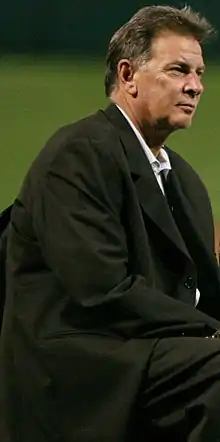 Flanagan in 2007
Flanagan in 2007
Michael Kendall Flanagan (December 16, 1951 – August 24, 2011) was an American professional baseball left-handed pitcher, front office executive, and color commentator. He spent 18 years as a player in Major League Baseball (MLB) with the Baltimore Orioles (1975–1987, 1991–1992) and the Toronto Blue Jays (1987–1990).
Flanagan was a starting pitcher for the Orioles from 1975 through 1987. He was named to the American League (AL) All-Star Team once in 1978. In 1979, the first of two years he would play on an AL pennant winner, his 23 victories led the circuit and earned him the AL's Cy Young Award. He was a member of the Orioles' World Series Championship team in 1983. During the 1987 season, he was traded to the Toronto Blue Jays, with whom he pitched through 1990. He returned to Baltimore to close out his playing career as a relief pitcher in 1991 and 1992. During this second tour, he combined with three other pitchers to throw a no-hitter against the Oakland Athletics on July 13, 1991. He was also the last Orioles pitcher to appear in a major-league contest at Memorial Stadium. In an 18-season career, Flanagan posted a 167–143 record with 1,491 strikeouts and a 3.90 earned run average in 2,770 innings pitched. (Full article...) Image 4
Image 4_(cropped).jpg.webp) Jankowski with the San Diego Padres in 2018
Jankowski with the San Diego Padres in 2018
Travis Paul Jankowski (born June 15, 1991) is an American professional baseball outfielder who is a free agent. He has played in Major League Baseball (MLB) for the San Diego Padres, Cincinnati Reds, Philadelphia Phillies, New York Mets, Seattle Mariners, and Texas Rangers.
Jankowski was born and raised in Lancaster, Pennsylvania. He attended Stony Brook University, where he led the Seawolves to a Cinderella appearance in the 2012 College World Series after upsetting the LSU Tigers. As a junior, Jankowski led college baseball in hits, runs scored and triples. That same year, the Padres selected him in the first round of the 2012 MLB Draft. (Full article...) Image 5
Image 5
The Redbirds–Sounds rivalry is a Minor League Baseball rivalry between Tennessee's two Triple-A baseball teams, the Memphis Redbirds and the Nashville Sounds. The teams compete in the West Division of the International League. Their games are played at Memphis' AutoZone Park and Nashville's First Horizon Park. From 2012 to 2015, the rivalry was incorporated into a promotion called the I-40 Cup Series.
Separated by an approximately 200-mile (320 km) stretch of Interstate 40, competition between professional baseball teams from Memphis and Nashville began in 1885 in the original Southern League. The cities later fielded teams in the Southern Association and modern Southern League. The rivalry between the Redbirds and Sounds began in 1998 when both teams became members of the Pacific Coast League and continued in 2021 following placement in the Triple-A East, which became the International League in 2022. (Full article...) Image 6
Image 6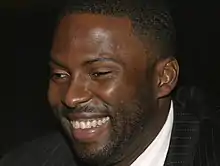 Bradley at the 2008 Major League Baseball All-Star Game
Bradley at the 2008 Major League Baseball All-Star Game
Milton Obelle Bradley, Jr. (born April 15, 1978) is an American former professional baseball outfielder. Standing 6 feet (1.8 m) and weighing 215 pounds (98 kg), Bradley was a switch hitter who threw right-handed. During an 11-year career in Major League Baseball, Bradley played with the Montreal Expos (2000–01), Cleveland Indians (2001–03), Los Angeles Dodgers (2004–05), Oakland Athletics (2006–07), San Diego Padres (2007), Texas Rangers (2008), Chicago Cubs (2009), and Seattle Mariners (2010–11). His career was also marred by legal troubles and several notable on-field incidents.
Born in Harbor City, California, Bradley attended Long Beach Polytechnic High School before he was drafted by the Expos in the 1996 Major League Baseball draft. After playing four seasons of minor league baseball for the organization, he made his major league debut on July 19, 2000. In 2001, Bradley was traded to the Cleveland Indians in exchange for pitching prospect Zach Day; he was again traded in 2004 to the Los Angeles Dodgers. After playing in 216 games for the Dodgers, the most among all teams he has played for, Bradley was traded to the Oakland Athletics for Andre Ethier. Bradley was traded to the Padres in 2007, was granted free agency after one season with the team, and signed with the Texas Rangers in 2007. He was voted to the 2008 Major League Baseball All-Star Game with the Rangers, and led the American League with a .436 on-base percentage and a .999 on-base plus slugging percentage. For the year, Bradley finished 17th in American League Most Valuable Player Award voting. (Full article...) Image 7
Image 7
KTXA (channel 21) is an independent television station in Fort Worth, Texas, United States, serving the Dallas–Fort Worth metroplex. It is owned by the CBS News and Stations group alongside Fort Worth–based CBS station KTVT (channel 11). Both stations share primary studio facilities on Bridge Street (off I-30), east of downtown Fort Worth, and advertising sales offices at CBS Tower on North Central Expressway in Dallas. KTXA's transmitter is located in Cedar Hill, Texas.
KTXA began broadcasting in January 1981 and was one of three new television stations in the Metroplex in six months. All three broadcast advertiser-supported commercial programming during the day and scrambled subscription television (STV) at night; KTXA's service, from ON TV, was hamstrung by the most intense competition in any STV market in the United States and by a dispute over adult programming, closing after two years. The station found success as an independent in a hot market and was sold twice in rapid succession for large amounts. However, when the independent station trade, advertising market, and regional economy cooled, it was sold again for less than half of its previous value. The Paramount Stations Group acquired KTXA and other stations in two parts between 1989 and 1991, bringing much-needed stability. (Full article...) Image 8
Image 8.jpg.webp) Robinson in 1959
Robinson in 1959
Brooks Calbert Robinson Jr. (May 18, 1937 – September 26, 2023) was an American baseball player who played his entire 23 seasons in Major League Baseball as third baseman for the Baltimore Orioles from 1955 to 1977. Nicknamed "Mr. Hoover" and "the Human Vacuum Cleaner", he is generally considered to have been the greatest defensive third baseman in major league history. An 18-time All-Star, he won 16 consecutive Gold Glove Awards, the most by a position player, and tied with Jim Kaat for the second-most of all-time, behind Greg Maddux. His 2,870 career games at third base not only exceeded the closest player by nearly 700 games when he retired, but also remain the most games by any player in major league history at a single position. His 23 seasons spent with a single team set a major league record since matched only by Carl Yastrzemski.
Joining the Orioles as a teenager in 1955, Robinson became the centerpiece of the team as they posted the best record in the major leagues between 1965 and 1974, capturing four American League (AL) pennants and two World Series titles. Beloved in Baltimore, Robinson was known as "Mr. Oriole" by the team's fans. He was named the AL Most Valuable Player (MVP) in 1964 after posting career highs with a .317 batting average, 28 home runs, and 118 runs batted in (RBIs), leading the AL in the last category. In 1966, he finished second in the MVP voting behind teammate Frank Robinson after again posting 100 RBIs as the Orioles won the pennant, before sweeping the Los Angeles Dodgers for the team's first Series title. (Full article...) Image 9
Image 9.jpg.webp) Galvis with the Philadelphia Phillies in 2015
Galvis with the Philadelphia Phillies in 2015
Freddy José Galvis (born November 14, 1989) is a Venezuelan professional baseball shortstop for the Fukuoka SoftBank Hawks of Nippon Professional Baseball (NPB). He has played in Major League Baseball (MLB). He previously played for the San Diego Padres, Toronto Blue Jays, Cincinnati Reds, Baltimore Orioles and Philadelphia Phillies.
Galvis was born in Punto Fijo, Falcón, Venezuela, and played Little League Baseball including the Little League World Series there before being discovered by one of the Phillies' scouts. At age 16, he signed a contract with the Phillies despite not receiving much attention from scouts. He spent the next several years in their minor league system, including a particularly lengthy stint with the Phillies' Double-A (AA) affiliate the Reading Phillies. He made his major league debut on Opening Day of 2012 at second base, substituting for the injured Chase Utley. He became a fan favorite for his performance early in the season, especially defensively, until he sustained an injury and subsequently was suspended for 50 games after a positive test for performance-enhancing drugs. He missed the remainder of the season. Over the course of the next two seasons, he split time between the Lehigh Valley IronPigs – the Phillies' Triple-A affiliate – and the major league ball club, but struggled to establish himself offensively. (Full article...) Image 10
Image 10
James Leroy Bottomley (April 23, 1900 – December 11, 1959) was an American professional baseball player, scout and manager. He played in Major League Baseball as a first baseman from 1922 to 1937, most prominently as a member of the St. Louis Cardinals where he helped lead the team to four National League pennants and two World Series titles.
Born in Oglesby, Illinois, Bottomley grew up in Nokomis, Illinois. He dropped out of high school at the age of 16 to raise money for his family. While he was playing semi-professional baseball, the Cardinals scouted and signed Bottomley before the 1920 season. He became an integral member of the Cardinals batting order, driving in 100 or more runs batted in between 1924 and 1929 as the team's cleanup hitter. In 1924, he established a major league record for driving in 12 runs in a nine inning game. (Full article...) Image 11Miguel Ángel Cuellar Santana (KWAY-ar; May 8, 1937 – April 2, 2010) was a Cuban professional baseball player. He played for 15 seasons in Major League Baseball as a left-handed pitcher in 1959 and from 1964 through 1977, most prominently as a member of the Baltimore Orioles who won the American League (AL) pennant in each of Cuellar's first three seasons with the team. During that time, Cuellar and the Orioles won the 1970 World Series. Cuellar also played for the Cincinnati Reds, St. Louis Cardinals, Houston Astros and California Angels.
Image 11Miguel Ángel Cuellar Santana (KWAY-ar; May 8, 1937 – April 2, 2010) was a Cuban professional baseball player. He played for 15 seasons in Major League Baseball as a left-handed pitcher in 1959 and from 1964 through 1977, most prominently as a member of the Baltimore Orioles who won the American League (AL) pennant in each of Cuellar's first three seasons with the team. During that time, Cuellar and the Orioles won the 1970 World Series. Cuellar also played for the Cincinnati Reds, St. Louis Cardinals, Houston Astros and California Angels.
Cuellar and Denny McLain each won the AL Cy Young Award in 1969, due to a tie in the voting. For the Orioles, Cuellar won 20-or-more games in a season four times from 1969 through 1974. Along with Jim Palmer, Dave McNally, and Pat Dobson, he was one of four Oriole starters to win at least 20 games in 1971. Cuellar, nicknamed "Crazy Horse" because of his superstitious nature, ranks among Baltimore's top five career leaders in wins (143), strikeouts (1,011), shutouts (30) and innings pitched (2,028). In 1982, Cuellar was inducted into the Baltimore Orioles Hall of Fame. (Full article...) Image 12
Image 12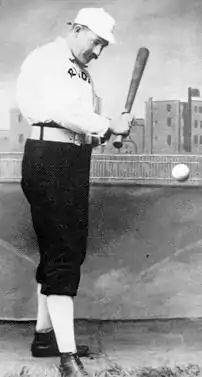
Dennis Joseph "Dan" Brouthers (/ˈbruːθərz/; May 8, 1858 – August 2, 1932) was an American first baseman in Major League Baseball whose career spanned the period from 1879 to 1896, with a brief return in 1904. Nicknamed "Big Dan" for his size, he was 6 feet 2 inches (1.88 m) and weighed 207 pounds (94 kg), which was large by 19th-century standards.
Recognized as the first great slugger in baseball history, and among the greatest sluggers of his era, he held the record for career home runs from 1887 to 1889, with his final total of 106 tying for the fourth most of the 19th century. His career slugging percentage of .519 remained the Major League record for a player with at least 4,000 at bats until Ty Cobb edged ahead of him in 1922. At the time of his initial retirement, he also ranked second in career triples (205), and third in runs batted in (1,296) and hits. (Full article...) Image 13
Image 13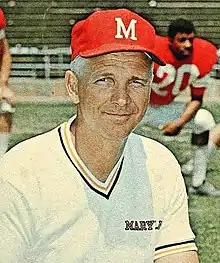 Lester, circa 1969
Lester, circa 1969
E. Roy Lester (October 3, 1923 – May 3, 2020) was an American college and high school football coach. After a successful career at the high school level, he served as the head coach of the University of Maryland football team from 1969 to 1971. Lester was the school's fourth head coach in five years, and compiled a 7–25 record during his tenure. He was fired after the 1971 season when Maryland finished at the bottom of the Atlantic Coast Conference for the second consecutive year.
Lester returned to coach interscholastic football, including as head coach of Richard Montgomery High School where his teams compiled an 86–10–1 record and six undefeated seasons. His high school teams won three Maryland state championships. Lester attended West Virginia University where he was a three-sport athlete and earned letters in football, baseball, and basketball. He was inducted into the West Virginia University Sports Hall of Fame in 2008. (Full article...) Image 14Charles Frank Lappenbusch Sr. (May 18, 1908 – September 30, 1996) was an American athlete and sports coach. He was best known for his time at Western Washington University, in which he served from 1933 to 1975 and coached football, basketball, baseball, tennis and golf.
Image 14Charles Frank Lappenbusch Sr. (May 18, 1908 – September 30, 1996) was an American athlete and sports coach. He was best known for his time at Western Washington University, in which he served from 1933 to 1975 and coached football, basketball, baseball, tennis and golf.
A native of Washington, Lappenbusch attended the University of Puget Sound before transferring to the University of Washington. He played as a lineman for both schools' football teams, and was named All-Pacific Northwest as a senior in 1930. Afterwards, he served for one year as an assistant football coach for Washington. In 1932, Lappenbusch became athletic director and head coach at Albany College (now known as Lewis & Clark College), a position in which he served for one season. (Full article...) Image 15
Image 15_(cropped).jpg.webp) Sandoval with the Los Angeles Angels in 2023
Sandoval with the Los Angeles Angels in 2023
Patrick Jordan Sandoval (born October 18, 1996) is an American professional baseball pitcher for the Los Angeles Angels of Major League Baseball (MLB).
Sandoval was born and raised in the Orange County city of Mission Viejo, California. He attended Mission Viejo High School, where he was a multi-sport athlete and became a notable baseball prospect with selections to all-county and all-league teams. Initially committed to play college baseball for Vanderbilt University and later for the University of Southern California, Sandoval forewent college when he was drafted by the Houston Astros in the 11th round of the 2015 MLB draft. (Full article...)
Did you know (auto-generated) -
- ... that the Strokes lose a game of baseball by a score of 56–1 against a team of robots in the music video for their song "The Adults Are Talking"?
- ... that the ownership group of San Diego's MLS team includes a Native American tribe and baseball player Manny Machado?
- ... that former baseball player Tacks Latimer was sentenced to life imprisonment for second-degree murder, but was pardoned for his heroism in stopping a prison break?
- ... that Devin Futrell used a post to dodge a draft?
- ... that Chris Gittens's father refused to attend any of his professional baseball games until he was promoted to the major leagues?
- ... that Cody Bellinger made a motion capture appearance in Assassin's Creed Valhalla as the Viking Otta Sluggasson, with Bellinger's own baseball bat serving as Sluggasson's weapon?
- ... that RealSports Baseball, part of Atari's response to an Intellivision marketing campaign fronted by George Plimpton, won a best sports game award for 1983?
- ... that after he retired from professional baseball, Paul Hinrichs became a Lutheran minister?
Quotes
 Featured lists -
Featured lists -
 Image 1The Golden Spikes Award is bestowed annually to the best amateur baseball player in the United States. The award, created by USA Baseball and sponsored by the Major League Baseball Players Association, was first presented in 1978. It is given to an amateur player who best exhibits and combines "exceptional on-field ability and exemplary sportsmanship". The award is considered the most prestigious in amateur baseball.
Image 1The Golden Spikes Award is bestowed annually to the best amateur baseball player in the United States. The award, created by USA Baseball and sponsored by the Major League Baseball Players Association, was first presented in 1978. It is given to an amateur player who best exhibits and combines "exceptional on-field ability and exemplary sportsmanship". The award is considered the most prestigious in amateur baseball.
Ten winners of the Golden Spikes Award are members of the National College Baseball Hall of Fame, including Bob Horner, the inaugural winner in 1978. In that same year, he was the first overall MLB draft pick and proceeded to win the Rookie of the Year Award. Seven Golden Spikes Award winners went on to become the first overall MLB draft pick. Only Horner achieved the MLB Rookie of the Year Award in the same year (although Jason Jennings and Buster Posey were voted the top rookies of the National League several years after winning the Golden Spikes Award). Jim Abbott, Jered Weaver and Tim Lincecum are the only award winners to pitch an MLB no-hitter, while Horner is the only one to hit four home runs in one MLB game. Furthermore, 17 players won the Dick Howser Trophy (considered to be the Heisman Trophy of college baseball) alongside the Golden Spikes Award. No player has won the award more than once, and no Golden Spikes recipient has yet been inducted into the National Baseball Hall of Fame. (Full article...) Image 2
Image 2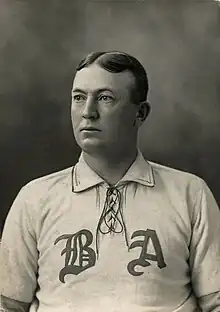 Cy Young is the all-time leader in wins.
Cy Young is the all-time leader in wins.
In Major League Baseball, the 300-win club is the group of pitchers who have won 300 or more games. Twenty-four pitchers have reached this milestone. This list does not include Bobby Mathews who won 297 in the major leagues plus several more in 1869 and 1870 before the major leagues were established in 1871. The San Francisco Giants are the only franchise to see four players reach 300 wins while on their roster: Tim Keefe in the Players' League, Christy Mathewson and Mickey Welch while the team was in New York, and most recently Randy Johnson. Early in the history of professional baseball, many of the rules favored the pitcher over the batter; the distance pitchers threw to home plate was shorter than today, and pitchers were able to use foreign substances to alter the direction of the ball. Moreover, pitchers started games far more frequently than modern pitchers do; in the second half of the 1884 season Old Hoss Radbourn started every other game. The first player to win 300 games was Pud Galvin in 1888. Seven pitchers recorded all or the majority of their career wins in the 19th century: Galvin, Cy Young, Kid Nichols, Keefe, John Clarkson, Charles Radbourn, and Welch. Four more pitchers joined the club in the first quarter of the 20th century: Mathewson, Walter Johnson, Eddie Plank, and Grover Cleveland Alexander. Young is the all-time leader in wins with 511, a mark that is considered unbreakable. If a modern-day pitcher won 20 games per season for 25 seasons, he would still be 11 games short of Young's mark.
Only three pitchers—Lefty Grove, Warren Spahn, and Early Wynn—joined the 300-win club between 1924 and 1982, which may be explained by a number of factors: the abolition of the spitball; World War II military service, such as Bob Feller's; and the growing importance of the home run in the game. As the home run became commonplace, the physical and mental demands on pitchers dramatically increased, which led to the use of a four-man starting rotation. Between 1982 and 1990, the 300-win club gained six members: Gaylord Perry, Phil Niekro, Steve Carlton, Nolan Ryan, Don Sutton, and Tom Seaver. These pitchers benefited from baseball's increase from a 154-game schedule to a 162-game schedule in 1961, and expansion of the league from 16 teams in 1960 to 26 by 1977. The increased use of specialized relief pitchers, an expanded strike zone, and new stadiums, including Shea Stadium, Dodger Stadium and the Astrodome, that were pitcher's parks all also suppressed offensive production. Also, the increasing sophistication of training methods and sports medicine - such as Tommy John surgery - allowed players to maintain a high competitive level for a longer time. Randy Johnson, for example, won more games in his 40s than he did in his 20s. (Full article...)![Image 3The Chicago Cubs are a professional baseball team based in Chicago, Illinois. The Cubs are members of the National League (NL) Central Division in Major League Baseball (MLB). In baseball, the head coach of a team is called the manager, or more formally, the field manager. The duties of the team manager include team strategy and leadership on and off the field. Since their inception as the White Stockings in 1876, the Cubs have employed 61 managers. The franchise's first manager was Baseball Hall of Famer Albert Spalding, who helped the White Stockings become the first champions of the newly formed National League.After co-managing with Silver Flint during the 1879 Chicago White Stockings season, Hall of Famer Cap Anson began an 18-year managerial tenure in 1880, the longest in franchise history. Under Anson, the team won five more NL pennants — in 1880, 1881, 1882, 1885 and 1886—tying the 1885 World Series and losing the 1886 World Series in the process.[a] Anson won 1,283 games as the White Stockings' manager, the most in franchise history. After taking over for Hall of Fame manager Frank Selee in 1905, Frank Chance — another Hall of Famer — managed the team through the 1912 season. During his tenure, the franchise won four more NL pennants in 1906, 1907, 1908, and 1910, winning its only two World Series titles in 1907 and 1908 until 2016 Chance's .664 career winning percentage is the highest of any Cubs manager. After Chance, from 1913 through 1960, the Cubs employed nineteen managers, nine of which were inducted into the Hall of Fame. During this period, the Cubs won six more NL pennants, including three under manager Charlie Grimm. Split between Grimm's two managerial stints in the 1930s and 1940s, plus a brief appearance as manager in 1960, Grimm accumulated 946 career wins, second-most in franchise history behind Anson. (Full article...)](../I/Blank.png.webp) Image 3The Chicago Cubs are a professional baseball team based in Chicago, Illinois. The Cubs are members of the National League (NL) Central Division in Major League Baseball (MLB). In baseball, the head coach of a team is called the manager, or more formally, the field manager. The duties of the team manager include team strategy and leadership on and off the field. Since their inception as the White Stockings in 1876, the Cubs have employed 61 managers. The franchise's first manager was Baseball Hall of Famer Albert Spalding, who helped the White Stockings become the first champions of the newly formed National League.
Image 3The Chicago Cubs are a professional baseball team based in Chicago, Illinois. The Cubs are members of the National League (NL) Central Division in Major League Baseball (MLB). In baseball, the head coach of a team is called the manager, or more formally, the field manager. The duties of the team manager include team strategy and leadership on and off the field. Since their inception as the White Stockings in 1876, the Cubs have employed 61 managers. The franchise's first manager was Baseball Hall of Famer Albert Spalding, who helped the White Stockings become the first champions of the newly formed National League.
After co-managing with Silver Flint during the 1879 Chicago White Stockings season, Hall of Famer Cap Anson began an 18-year managerial tenure in 1880, the longest in franchise history. Under Anson, the team won five more NL pennants — in 1880, 1881, 1882, 1885 and 1886—tying the 1885 World Series and losing the 1886 World Series in the process.[a] Anson won 1,283 games as the White Stockings' manager, the most in franchise history. After taking over for Hall of Fame manager Frank Selee in 1905, Frank Chance — another Hall of Famer — managed the team through the 1912 season. During his tenure, the franchise won four more NL pennants in 1906, 1907, 1908, and 1910, winning its only two World Series titles in 1907 and 1908 until 2016 Chance's .664 career winning percentage is the highest of any Cubs manager. After Chance, from 1913 through 1960, the Cubs employed nineteen managers, nine of which were inducted into the Hall of Fame. During this period, the Cubs won six more NL pennants, including three under manager Charlie Grimm. Split between Grimm's two managerial stints in the 1930s and 1940s, plus a brief appearance as manager in 1960, Grimm accumulated 946 career wins, second-most in franchise history behind Anson. (Full article...) Image 4
Image 4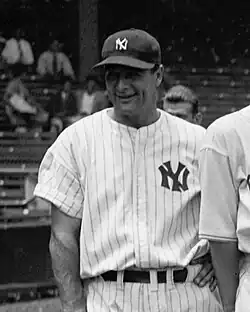 Lou Gehrig, the namesake of the award
Lou Gehrig, the namesake of the award
The Lou Gehrig Memorial Award is given annually to a Major League Baseball (MLB) player who best exhibits the character and integrity of Lou Gehrig, both on the field and off it. The award was created by the Phi Delta Theta fraternity in honor of Gehrig, who was a member of the fraternity at Columbia University. It was first presented in 1955, fourteen years after Gehrig's death. The award's purpose is to recognize a player's exemplary contributions in "both his community and philanthropy." The bestowal of the award is overseen by the headquarters of the Phi Delta Theta in Oxford, Ohio, and the name of each winner is inscribed onto the Lou Gehrig Award plaque in the Baseball Hall of Fame in Cooperstown, New York. It is the only MLB award conferred by a fraternity.
Twenty-eight winners of the Lou Gehrig Memorial Award are members of the National Baseball Hall of Fame. The inaugural winner was Alvin Dark. Curt Schilling (1995) and Shane Victorino (2008) received the award for working with the ALS Association and raising money for amyotrophic lateral sclerosis (ALS). The disease took Gehrig's life and is eponymously known as "Lou Gehrig's disease". Mike Timlin won the award in 2007 for his efforts in raising awareness and finding a cure for ALS, which took his mother's life in 2002. (Full article...) Image 5
Image 5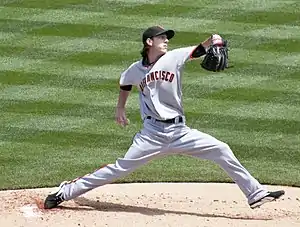 Tim Lincecum (2006) won two Cy Young Awards with the Giants.
Tim Lincecum (2006) won two Cy Young Awards with the Giants.
The San Francisco Giants are a Major League Baseball (MLB) franchise based in San Francisco, California. They play in the National League West division. Officially known as the "First-Year Player Draft", the Rule 4 Draft is MLB's primary mechanism for assigning players from high schools, colleges, and other amateur clubs to its franchises. The draft order is determined based on the previous season's standings, with the team possessing the worst record receiving the first pick. In addition, teams which lost free agents in the previous off-season may be awarded compensatory or supplementary picks. Since the establishment of the draft in 1965, the Giants have selected 70 players in the first round.
Of those 70 players, 32 have been pitchers, the most of any position; 23 of these were right-handed, while 9 were left-handed. The Giants have also selected thirteen outfielders, seven shortstops, seven catchers, four third basemen, and three players each at first and second base. One player, 2010 selection Gary Brown, was drafted as a center fielder. The franchise has drafted eight players from colleges or high schools in their home state of California, more than any other. The Giants have never held the first-overall pick, but they did have the second pick in 1985, with which they drafted Will Clark. (Full article...) Image 6
Image 6 Babe Ruth was the first player to reach 500 home runs and set a career home run mark of 714 that stood until 1974.
Babe Ruth was the first player to reach 500 home runs and set a career home run mark of 714 that stood until 1974.
In Major League Baseball (MLB), the 500 home run club is a group of batters who have hit 500 or more regular-season home runs in their careers. There are twenty-eight players who are members of the 500 home run club. Seven 500 home run club members—Hank Aaron, Willie Mays, Eddie Murray, Rafael Palmeiro, Albert Pujols, Alex Rodriguez and Miguel Cabrera—are also members of the 3,000 hit club.
In the past, membership in the 500 home run club was a guarantee of eventual entry into the Baseball Hall of Fame, although some believe the milestone has become less meaningful in recent years and many members have not been enshrined in Cooperstown. (Full article...) Image 7
Image 7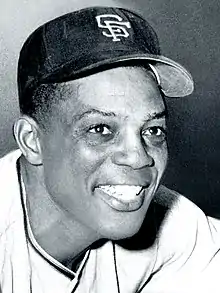 Willie Mays (NL) was the first player to win more than one All-Star Game MVP Award (1963, 1968).
Willie Mays (NL) was the first player to win more than one All-Star Game MVP Award (1963, 1968).
The Major League Baseball All-Star Game Most Valuable Player (MVP) Award is an annual Major League Baseball (MLB) award that is presented to the most outstanding player in each year's MLB All-Star Game. Awarded each season since 1962 (two games were held and an award was presented to each game winner in 1962), it was originally called the Arch Ward Memorial Award in honor of Arch Ward, the man who conceived of the All-Star Game in 1933. The award's name was changed to the Commissioner's Trophy in 1970 (two National League (NL) players were presented the award in 1975), but this name change was reversed in 1985 when the World Series Trophy was renamed the Commissioner's Trophy. Finally, the trophy was renamed the Ted Williams Most Valuable Player Award in 2002, in honor of former Boston Red Sox player Ted Williams, who had died earlier that year. No award was presented for the 2002 All-Star Game, which ended in a tie. Thus, the Anaheim Angels' Garret Anderson was the first recipient of the newly named Ted Williams Award in 2003. The All-Star Game Most Valuable Player also receives a Chevrolet vehicle, choosing between two cars.
, NL players have won the award 28 times (including one award shared by two players), and American League (AL) players have won 33 times. Baltimore Orioles players have won the most awards for a single franchise (with six); players from the Cincinnati Reds, Los Angeles Dodgers and San Francisco Giants are tied for the most in the NL with five each. Five players have won the award twice: Willie Mays (1963, 1968), Steve Garvey (1974, 1978), Gary Carter (1981, 1984), Cal Ripken Jr. (1991, 2001), and Mike Trout (2014, 2015, becoming the only player to win the award in back-to-back years). The award has been shared by multiple players once; Bill Madlock and Jon Matlack shared the award in 1975. Two players have won the award for a game in which their league lost: Brooks Robinson in 1966 and Carl Yastrzemski in 1970. One pair of awardees were father and son (Ken Griffey Sr. and Ken Griffey Jr.), and another were brothers (Roberto Alomar and Sandy Alomar Jr.). Three players have won the MVP award at a game played in their home ballpark (Sandy Alomar Jr. in 1997, Pedro Martínez in 1999, and Shane Bieber in 2019). Derek Jeter is the only player to win the All-Star Game MVP and World Series MVP in the same season, doing so in 2000. (Full article...) Image 8
Image 8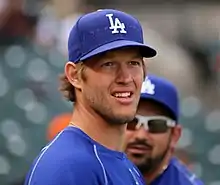 Clayton Kershaw holds the Dodgers' record for most Opening Day starts with nine (2011–2018 & 2021).
Clayton Kershaw holds the Dodgers' record for most Opening Day starts with nine (2011–2018 & 2021).
The Los Angeles Dodgers are a Major League Baseball (MLB) franchise based in Los Angeles. They play in the National League West division. The first game of the new baseball season for a team is played on Opening Day, and being named the Opening Day starter is an honor, which is often given to the player who is expected to lead the pitching staff that season, though there are various strategic reasons why a team's best pitcher might not start on Opening Day. The Dodgers have used 25 different Opening Day starting pitchers in their 66 seasons in Los Angeles. The 25 starters have a combined Opening Day record of 29 wins, 27 losses and 9 no decisions.
The Dodgers started playing in Los Angeles in 1958, after moving from Brooklyn. The first Opening Day game for the Dodgers in Los Angeles was played in San Francisco against the San Francisco Giants on April 15, 1958. California native Don Drysdale was the Dodgers' Opening Day starting pitcher that day, in a game the Dodgers lost 8–0. Dodgers starting pitchers won both of their Opening Day starts in their first home ballpark in Los Angeles, Los Angeles Memorial Coliseum. (Full article...) Image 9
Image 9 Mariano Rivera won the AL Relief Man Award in 1999, 2001, 2004, 2005, and 2009.
Mariano Rivera won the AL Relief Man Award in 1999, 2001, 2004, 2005, and 2009.
The Rolaids Relief Man Award was an annual Major League Baseball (MLB) award given from 1976 to 2012 to the top relief pitchers of the regular season, one in the American League (AL) and one in the National League (NL).
Relief pitchers enter the game after the starting pitcher is removed. The award was sponsored by the antacid brand Rolaids, whose slogan was "R-O-L-A-I-D-S spells relief." Because the first closers were nicknamed "firemen", a reference to "putting out the fire" of another team's rally, the trophy was a gold-plated firefighter's helmet. (Full article...) Image 10
Image 10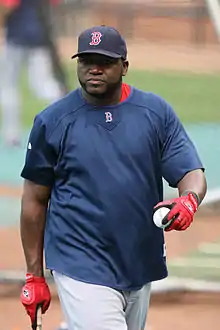 David Ortiz has won the most Silver Slugger Awards as a designated hitter, with seven.
David Ortiz has won the most Silver Slugger Awards as a designated hitter, with seven.
The Silver Slugger Award is awarded annually to the best offensive player at each position in both the American League (AL) and the National League (NL), as determined by the coaches and managers of Major League Baseball (MLB). These voters consider several offensive categories in selecting the winners, including batting average, slugging percentage, and on-base percentage, in addition to "coaches' and managers' general impressions of a player's overall offensive value". Managers and coaches are not permitted to vote for players on their own team. The Silver Slugger was first awarded in 1980 and is given by Hillerich & Bradsby, the manufacturer of Louisville Slugger bats. The award is a bat-shaped trophy, 3 feet (91 cm) tall, engraved with the names of each of the winners from the league and plated with sterling silver.
From 1980 to 2019, and in 2021, a Silver Slugger Award for designated hitters (DH) was only given in the American League, because use of a DH in place of the pitcher in the batting order was prohibited in the National League; a Silver Slugger Award for pitchers was given for the National League instead. In the 2020 season, the National League temporarily allowed use of the designated hitter, and no pitcher was awarded the Silver Slugger Award. An award was given instead to the best designated hitter in the National League. The first NL Silver Slugger Award for designated hitter was given to Marcell Ozuna. Beginning in 2022, the pitcher Silver Slugger Award was retired after MLB announced the full-time implementation of the universal DH rule in both leagues. The Silver Slugger Award for DH is now awarded in both leagues. (Full article...) Image 11
Image 11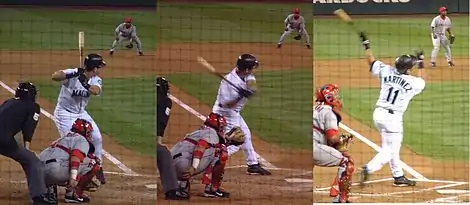 The award was renamed in honor of Edgar Martínez, a five-time winner, upon his retirement.
The award was renamed in honor of Edgar Martínez, a five-time winner, upon his retirement.
The Edgar Martínez Outstanding Designated Hitter Award, commonly referred to as the Edgar Martínez Award and originally known as the Outstanding Designated Hitter Award, has been presented annually to the most outstanding designated hitter (DH) in Major League Baseball (MLB) since 1973. The award is voted on by club beat reporters, broadcasters, and public relations departments. The Associated Press discontinued the award in 2000, but it was picked up by the Baseball Writers' Association of America, which has administered it since. All players with a minimum of 100 at bats at DH are eligible. From the award's inception in 1973 until 2019, and in 2021, use of the designated hitter was allowed only in the American League (AL).
In September 2004, at Safeco Field ceremonies in honor of Edgar Martínez, Commissioner Bud Selig announced that the award would be renamed for the five-time recipient (1995, 1997–98, 2000–01). In an 18-year career with the Seattle Mariners, primarily as a designated hitter, Martínez batted .312, with 309 career home runs and 1,261 runs batted in. (Full article...) Image 12
Image 12 An AT&T Park sign depicting the anticipation of #714
An AT&T Park sign depicting the anticipation of #714
Barry Bonds hit numerous milestone home runs during his 22 seasons in Major League Baseball with the Pittsburgh Pirates and San Francisco Giants. Bonds ranks among the greatest baseball players of all time and was for much of his career considered a five-tool player. Bonds' ascension towards the top of experts' lists of greatest players was propelled by highly productive years in which he set many records. By 1998, he was considered among the 50 greatest players of all time by The Sporting News, and after winning the National League's Most Valuable Player Award four consecutive times from 2001–2004, he jumped into the top 10 in the 2005 list. He now holds numerous Major League Baseball records for home runs, bases on balls, intentional bases on balls, slugging percentage and on-base percentage, as well as a record seven MVP awards.
In baseball, the home run is one of the most popular aspects of the game. Thus, the career record for home runs is among the most important and respected records in baseball. The road to this record has been closely followed and each additional home run Bonds hits extends the current record further. On August 7, 2007, Barry Bonds became the major leagues' career home run champion by hitting his 756th career home run, which surpassed Hank Aaron's total. (Full article...)![Image 13The 1971 Cy Young Award won by Ferguson Jenkins, on display in the Canadian Baseball Hall of FameThe Cy Young Award is given annually to the best pitchers in Major League Baseball (MLB), one each for the American League (AL) and National League (NL). The award was introduced in 1956 by Baseball Commissioner Ford Frick in honor of Hall of Fame pitcher Cy Young, who died in 1955. The award was originally given to the single best pitcher in the major leagues, but in 1967, after the retirement of Frick, the award was given to one pitcher in each league.Each league's award is voted on by members of the Baseball Writers' Association of America, with one representative from each team. As of the 2010 season, each voter places a vote for first, second, third, fourth, and fifth place among the pitchers of each league. The formula used to calculate the final scores is a weighted sum of the votes.[A] The pitcher with the highest score in each league wins the award. If two pitchers receive the same number of votes, the award is shared. From 1970 to 2009, writers voted for three pitchers, with the formula of five points for a first-place vote, three for a second-place vote and one for a third-place vote. Before 1970, writers only voted for the best pitcher and used a formula of one point per vote. (Full article...)](../I/Blank.png.webp) Image 13
Image 13.jpg.webp) The 1971 Cy Young Award won by Ferguson Jenkins, on display in the Canadian Baseball Hall of Fame
The 1971 Cy Young Award won by Ferguson Jenkins, on display in the Canadian Baseball Hall of Fame
The Cy Young Award is given annually to the best pitchers in Major League Baseball (MLB), one each for the American League (AL) and National League (NL). The award was introduced in 1956 by Baseball Commissioner Ford Frick in honor of Hall of Fame pitcher Cy Young, who died in 1955. The award was originally given to the single best pitcher in the major leagues, but in 1967, after the retirement of Frick, the award was given to one pitcher in each league.
Each league's award is voted on by members of the Baseball Writers' Association of America, with one representative from each team. As of the 2010 season, each voter places a vote for first, second, third, fourth, and fifth place among the pitchers of each league. The formula used to calculate the final scores is a weighted sum of the votes.[A] The pitcher with the highest score in each league wins the award. If two pitchers receive the same number of votes, the award is shared. From 1970 to 2009, writers voted for three pitchers, with the formula of five points for a first-place vote, three for a second-place vote and one for a third-place vote. Before 1970, writers only voted for the best pitcher and used a formula of one point per vote. (Full article...) Image 14
Image 14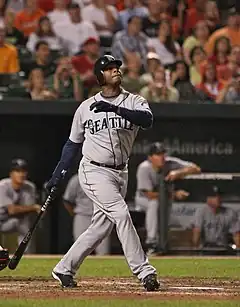 Ken Griffey Jr. playing for the Mariners in June 2009. Griffey Jr. holds five single-season batting records and an individual career record for the Mariners franchise.
Ken Griffey Jr. playing for the Mariners in June 2009. Griffey Jr. holds five single-season batting records and an individual career record for the Mariners franchise.
The Seattle Mariners are a Major League Baseball (MLB) team who have participated in 46 seasons since their inception in 1977. Through July 16, 2022, they have played 7,156 games, winning 3,385, losing 3,769, and tying two, for a winning percentage of .473. This list documents the superlative records and accomplishments of team members during their tenures as Seattle Mariners in Major League Baseball's American League West.
Ichiro Suzuki holds the most franchise records as of the end of the 2012 season, with ten, including best single-season batting average, most career hits, and most career triples. He is followed by Edgar Martínez, who holds nine records, including best career on-base percentage and the single-season walk record. (Full article...)![Image 15In baseball, earned run average (ERA) is a statistic used to evaluate pitchers, calculated as the mean of earned runs given up by a pitcher per nine innings pitched.[a] A pitcher is assessed an earned run for each run scored by a baserunner who reached base while batting against that pitcher, whether by hit, base on balls or "walk", or being hit by a pitched ball; an earned run can be charged after the pitcher is relieved if he allows the runner before leaving the game. Runs scored by players who reach base on errors, passed balls, or catcher interference under special circumstances are treated as unearned runs, and do not count towards the pitcher's ERA.Major League Baseball recognizes the player in each league[b] with the lowest earned run average each season.[c] The first ERA champion in the National League was George Bradley; in the National League's inaugural 1876 season, Bradley posted a 1.23 ERA for the St. Louis Brown Stockings, allowing 78 earned runs in 573 innings pitched. The American League was established in 1901, and Hall of Fame pitcher Cy Young led that league with a 1.62 ERA for the Boston Americans during the 1901 season. (Full article...)](../I/Blank.png.webp) Image 15In baseball, earned run average (ERA) is a statistic used to evaluate pitchers, calculated as the mean of earned runs given up by a pitcher per nine innings pitched.[a] A pitcher is assessed an earned run for each run scored by a baserunner who reached base while batting against that pitcher, whether by hit, base on balls or "walk", or being hit by a pitched ball; an earned run can be charged after the pitcher is relieved if he allows the runner before leaving the game. Runs scored by players who reach base on errors, passed balls, or catcher interference under special circumstances are treated as unearned runs, and do not count towards the pitcher's ERA.
Image 15In baseball, earned run average (ERA) is a statistic used to evaluate pitchers, calculated as the mean of earned runs given up by a pitcher per nine innings pitched.[a] A pitcher is assessed an earned run for each run scored by a baserunner who reached base while batting against that pitcher, whether by hit, base on balls or "walk", or being hit by a pitched ball; an earned run can be charged after the pitcher is relieved if he allows the runner before leaving the game. Runs scored by players who reach base on errors, passed balls, or catcher interference under special circumstances are treated as unearned runs, and do not count towards the pitcher's ERA.
Major League Baseball recognizes the player in each league[b] with the lowest earned run average each season.[c] The first ERA champion in the National League was George Bradley; in the National League's inaugural 1876 season, Bradley posted a 1.23 ERA for the St. Louis Brown Stockings, allowing 78 earned runs in 573 innings pitched. The American League was established in 1901, and Hall of Fame pitcher Cy Young led that league with a 1.62 ERA for the Boston Americans during the 1901 season. (Full article...)
More did you know
- ... that Negro league baseball executive Cum Posey organized the East-West League in 1932, but the league folded before the end of the season?
- ... that Freeman Fitzgerald played football with Knute Rockne and once struck out 19 batters in a baseball game?
- ... that despite being named one of the "top prospects of the decade" by Baseball America, American baseball pitcher Nick Neugebauer compiled a career record of just two wins and eight losses?
- ... that Milwaukee Brewers baseball player Dan Thomas was called the "Sundown Kid" because he refused to play on Sabbath?
- ... that when Roger Bresnahan adopted the use of shin guards in Major League Baseball on Opening Day in 1907, angry fans threw snow onto the field?
Sports portals
Selected picture
-edit3.jpg.webp)
Christopher Ryan Young (born May 25, 1979, in Dallas) is a starting pitcher for the San Diego Padres of Major League Baseball. He made his major league debut on August 24, 2004, for the Texas Rangers. He had previously excelled in basketball and baseball at Highland Park High School in University Park, Texas and Princeton University.
Associated Wikimedia
The following Wikimedia Foundation sister projects provide more on this subject:
-
 Commons
Commons
Free media repository -
 Wikibooks
Wikibooks
Free textbooks and manuals -
 Wikidata
Wikidata
Free knowledge base -
 Wikinews
Wikinews
Free-content news -
 Wikiquote
Wikiquote
Collection of quotations -
 Wikisource
Wikisource
Free-content library -
 Wikiversity
Wikiversity
Free learning tools -
 Wiktionary
Wiktionary
Dictionary and thesaurus
More portals
-
 List of all portalsList of all portals
List of all portalsList of all portals -
 The arts portal
The arts portal -
 Biography portal
Biography portal -
 Current events portal
Current events portal -
 Geography portal
Geography portal -
 History portal
History portal -
 Mathematics portal
Mathematics portal -
 Science portal
Science portal -
 Society portal
Society portal -
 Technology portal
Technology portal -
 Random portalRandom portal
Random portalRandom portal -
 WikiProject PortalsWikiProject Portals
WikiProject PortalsWikiProject Portals